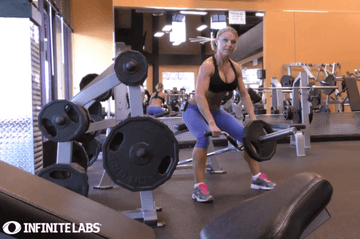

6 Simple Rules to follow for Avoiding Injuries
Table of Contents
| by: Joe Palumbo |
With error returns wisdom and experience. Throughout my 30 years of training I have had my share of injuries. Training injuries can really throw a wrench into anyone’s fitness program. Learn to avoid injuries before they happen and save your self-a lot of pain.
NO PAIN NO GAIN?
One of the most important things about training is to recognize the “Good” pain from the “Bad” pain. Pain is the body’s defense mechanism warning you that injury is occurring or has occurred. The pain of lactic acid build-up in the muscle is acceptable as you push reps to the limit however; sharp, searing, hot needle pain is a different story. This means a real injury is occurring, it is imperative that you immediately stop what you are doing. Try to determine the severity of the injury, immediately apply ice directly over the area of pain. This will help to reduce the swelling and inflammation. If the injury prevents you from moving your limbs in any direction, seek medical attention right away.
Now with that said follow these simple steps and many serious injuries can be avoided
WARM UP
 This is a step many people skip because they just don’t have the time, big mistake… huge! Your warm-up is the key to unlocking tight muscles, therefore when skipped it can cause an injury. A warm up is usually a high rep, low intensity, and quick paced exercise to increase blood flow to the muscle. Chose an exercise for the muscle you want to work out start off with a lightweight and do 2 to 3 sets of 20 – 30 repetitions, without any kind of struggle. The idea is to stretch and pump the area with a flow of blood to warm the muscle up.
This is a step many people skip because they just don’t have the time, big mistake… huge! Your warm-up is the key to unlocking tight muscles, therefore when skipped it can cause an injury. A warm up is usually a high rep, low intensity, and quick paced exercise to increase blood flow to the muscle. Chose an exercise for the muscle you want to work out start off with a lightweight and do 2 to 3 sets of 20 – 30 repetitions, without any kind of struggle. The idea is to stretch and pump the area with a flow of blood to warm the muscle up.
STRETCHING
 Stretching is different from your warm up, a stretch helps relax and elongate a muscle after warm up and before weight training. The proper method of performing a stretching program is to take your time and allow your muscle to lengthen gradually as you bend and reach, NO BOUNCING OR JERKING. In all stretches you are trying for a maximum effort or bend, endeavor to hold the point of full extension for a full 15 seconds. Warming up and stretching is the most common left out part of a training program and the biggest mistake anyone can make.
Stretching is different from your warm up, a stretch helps relax and elongate a muscle after warm up and before weight training. The proper method of performing a stretching program is to take your time and allow your muscle to lengthen gradually as you bend and reach, NO BOUNCING OR JERKING. In all stretches you are trying for a maximum effort or bend, endeavor to hold the point of full extension for a full 15 seconds. Warming up and stretching is the most common left out part of a training program and the biggest mistake anyone can make.
TECHNIQUE
Some of the most common weight training injuries are related to poor exercise technique. It is essential to take particular care in certain exercises. Let’s take a few examples: The squat, always keep your back flat, head up, and lower slowly to the thigh-parallel-to-floor position. Never bounce out of a squat. Deadlifts should also be performed with a flat back, head up. Do not rebound the weight from the floor. When performing bent-over rowing, keep your knees slightly bent, back flat. When you cannot complete a rep using the proper form and technique, STOP…Do not squirm and twist your body. Master the correct techniques for every exercise perform is the most important for avoiding injuries.
STAY HYDRATED
 Muscle is considered an active tissue and water is found in the highest concentrations in active tissue. In order to move muscle, you need water. The electrical stimulation of nerves and contraction of muscles are the result of the exchange of electrolyte minerals dissolved in water. It’s essential that you drink water for health and building muscle. Without enough water, your muscles are not getting enough electrolytes. If you want to build muscle than you must keep your body well hydrated at all times. Water does many things for our body, one of the most important tasks water has is lubing up joints for maximum and pain-free movement. Injury can be a result of joints not being cushioned, water can aid in this by helping to lubricate and provide padding for these areas.
Muscle is considered an active tissue and water is found in the highest concentrations in active tissue. In order to move muscle, you need water. The electrical stimulation of nerves and contraction of muscles are the result of the exchange of electrolyte minerals dissolved in water. It’s essential that you drink water for health and building muscle. Without enough water, your muscles are not getting enough electrolytes. If you want to build muscle than you must keep your body well hydrated at all times. Water does many things for our body, one of the most important tasks water has is lubing up joints for maximum and pain-free movement. Injury can be a result of joints not being cushioned, water can aid in this by helping to lubricate and provide padding for these areas.
OVERTRAINING
 When you over train your muscle, it just becomes weak and smaller! It is the rest that make you stronger. During recovery period the body compensates for the stress that has been applied. The result is a higher level of performance. When you begin to see results from your training you may be tempted to take it one step future and double your training however excessive training will not lead to faster gains it will however increase your risk if injury. Listen to your body; remember the good pain from the bad.
When you over train your muscle, it just becomes weak and smaller! It is the rest that make you stronger. During recovery period the body compensates for the stress that has been applied. The result is a higher level of performance. When you begin to see results from your training you may be tempted to take it one step future and double your training however excessive training will not lead to faster gains it will however increase your risk if injury. Listen to your body; remember the good pain from the bad.
It is safe to say that virtually all athletes endure the constant risk of injury, we keep pushing our bodies more and more to achieve perfection. Even a small muscle strain can keep you away from an important exercise for many months. In most cases, a torn muscle or strain, or a sprain needs rest and ice. Subsequent training must therefore not involve the affected area until it has healed itself. Then with great caution, resume regular training, always mindful of the mistake that caused the injury in the first place and of course learn to adapt and overcome.
Be Safe
Joe Palumbo

IFBB Pro
Certified Personal Trainer
Certified Trainer
Advance Sports Nutrition Specialist (ASNS)
Certified Navy Seal fitness Instructor
Contact Joe @ Joeswat5@aol.com
MUSCLE MEDIA MAGAZINE FOR MEN
The premier source of training, nutrition, supplements, fat loss and health for men.

















